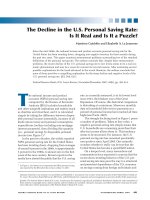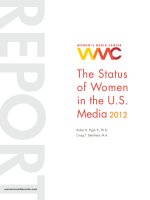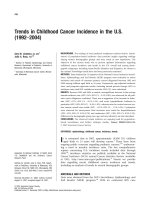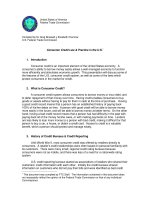Market structure and regulation in the u s banking industry
Bạn đang xem bản rút gọn của tài liệu. Xem và tải ngay bản đầy đủ của tài liệu tại đây (578.87 KB, 67 trang )
Market Structure and Regulation in
the U.S. Banking Industry
Professor Wayne Carroll
Department of Economics
University of Wisconsin-Eau Claire
Slides available at www.uwec.edu/carrolwd
Roles of Banks in the Economy
Facilitate borrowing and lending
Facilitate payments
Risk management
Issue financial assets that allow firms to share
risks
Provide guarantees and lines of credit
Role of Banks in Lending
Source: Available online at />
Financial Intermediaries
“Banks” include:
Commercial banks
Savings and loan associations (S&L’s)
Also sometimes called “thrifts” or “thrift
institutions”
Credit unions
Financial Intermediaries
Assets at end of 2002 (in billions)
Ownership of Banks
U.S. banks are privately owned – no banks
are owned by the government.
In most cases a bank’s stock is held by a
large number of investors, so a bank has
many “owners.”
It is relatively easy to establish a new bank in
the U.S.
Bank Market Structure
There are a large number of banking firms in
the U.S., but the number is falling due to
mergers between banks.
Thousands of U.S. banks are very small,
each having only a single office.
Many banks today have multiple branches or
offices.
A “bank holding company” is a firm that owns
one or more banking firms.
Size Distribution of U.S. Banks
Commercial Banks
Number of
Asset Size
(as of June 30, 2006)
Institutions
Offices
Deposits
(millions)
586
712
$7,661
$25 Million to $50 Million
1,098
1,701
$33,511
$50 Million to $100 Million
1,718
4,007
$105,754
$100 Million to $300 Million
2,427
10,338
$349,740
$300 Million to $500 Million
672
5,088
$211,495
$500 Million to $1 Billion
494
6,322
$265,540
$1 Billion to $3 Billion
275
6,856
$338,909
$3 Billion to $10 Billion
120
6,601
$427,340
Greater than $10 Billion
89
38,848
$3,580,817
7,479
80,473
$5,320,767
Less than $25 Million
TOTALS
Source: www2.fdic.gov/sod/index.asp
Bank Market Structure: An Example
Wells Fargo & Company is a bank
holding company based in South Dakota
(with historic roots in Minnesota and
California). It includes:
28 chartered bank companies
a total of over 3,000 branches in 23
states
Some Wells Fargo branches
Wells Fargo’s Broad Scope
Source: www.wellsfargo.com/about/today1
20 Largest U.S. Banks
(as of June 30, 2006)
Rank
Institution Name
State
Headquartered
Number of
Offices
Deposits
(thousands)
1
Bank of America, NA
North Carolina
5,781
$563,906,844
2
JPMorgan Chase Bank, NA
Ohio
2,679
$434,752,000
3
Wachovia Bank, NA
North Carolina
3,136
$306,348,000
4
Wells Fargo Bank, NA
South Dakota
3,200
$298,672,000
5
Washington Mutual Bank
Nevada
2,167
$209,927,984
6
Citibank, NA
New York
267
$142,508,000
7
SunTrust Bank
Georgia
1,758
$117,956,301
8
U.S. Bank, NA
Ohio
2,525
$117,337,830
9
HSBC Bank USA, NA
Delaware
436
$75,588,320
10
World Savings Bank, FSB
California
286
$61,321,407
11
PNC Bank, NA
Pennsylvania
831
$58,134,805
12
Keybank, NA
Ohio
957
$57,327,323
13
Regions Bank
Alabama
1,397
$57,231,022
14
Merrill Lynch Bank USA
Utah
3
$52,331,967
15
Branch Banking and Trust Company
North Carolina
918
$51,246,133
16
Countrywide Bank, NA
Virginia
2
$50,657,812
17
ING Bank, fsb
Delaware
1
$46,440,495
18
Comerica Bank
Michigan
387
$43,081,270
19
Sovereign Bank
Pennsylvania
661
$40,829,851
20
The Bank of New York
New York
354
$40,014,000
Source: www2.fdic.gov/sod/index.asp
A Simple Bank Balance Sheet
Assets
reserves
"loans"
securities
bank
loans
Liabilities
deposits
borrowings
Bank capital
(equity)
Detailed Balance Sheet for the Banking Industry
Source: Mishkin, Economics of Money, Banking, and Financial Markets, 7 th edition
Two Important Ratios
Capital/asset ratio – bank capital as a
percentage of bank assets.
The average capital/asset ratio for U.S. banks
was about 9% at the end of 2002.
Reserve ratio – bank reserves as a
percentage of checkable deposits.
Information on U.S. Banks
It is easy to get a lot of financial data on U.S.
banks.
A great source:
www2.fdic.gov/idasp/index.asp
An Example: Data on Wells Fargo
What Can Go Wrong?
“Bank failure” – the bank goes out of
business.
Bank depositors might lose some of their
funds.
Bank creditors might lose some of their
investment
Bank owners lose their capital.
The bank suffers significant losses – the
government might have to help.
Reasons for Bank Regulation
Banks must be regulated because:
a bank failure can be devastating to depositors.
there’s a risk of systemic failure: the failure of
one bank can make it more likely that other
banks will fail.
depositors can’t monitor how the bank invests
their funds, creating a moral hazard problem.
government assistance to a bank can be very
costly.
Reasons for Bank Regulation
Banks are less stable than other businesses
because:
bank liabilities tend to be short-term – many
depositors could withdraw their funds with little
notice.
bank assets tend to be longer-term – reserves
and other liquid assets are only a small share of
the total.
the behavior of depositors depends on their
confidence that the bank is sound, and this
confidence can be easily shaken.
A Closer Look at Bank Failure
Two reasons for bank failure:
The value of bank assets falls, so
assets
withdraw their funds from the bank,
exhausting the bank’s cash (reserves) and
other liquid assets.
Therefore a bank is more likely to fail if it has
a low capital/asset ratio or a low reserve ratio.
A Closer Look at Bank Failure
Tradeoff between higher income and a lower
risk of failure:
Holding other things constant, the bank’s net
income is higher if its capital/asset ratio and
reserve ratio are lower, since then it holds
relatively more interest-earning assets.
If the bank’s capital/asset ratio and reserve
ratio are higher, it’s less likely that the bank
will fail (so it’s less likely that the stockholders
will lose their capital.)
A Closer Look at Bank Failure
If there were no government regulation of
banks:
each bank would choose a capital/asset ratio
and a reserve ratio to maximize the value of the
bank.
depositors would want to deposit their money in
banks that are well managed, so banks would
have an incentive to choose capital/asset ratios
and reserve ratios that reduce the threat of bank
failure.
“market discipline”
A Closer Look at Bank Failure
But if there were no government regulation of
banks:
banks would choose capital/asset ratios and
reserve ratios that are too low from society’s
standpoint.
banks would take on too much risk, so there
would be too many bank failures, and the
government would have to spend too much
money to assist troubled banks.
An Example:
Continental Illinois Bank
Continental Illinois Bank failed in 1984.
The federal government paid billions of
dollars to keep Continental Illinois from
closing.
This was the biggest bank “resolution” in U.S.
history.









